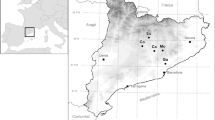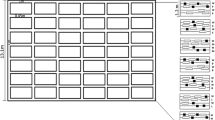Abstract
Increasing plant diversity within crops can be beneficial for pest control. In this field study, the effects of two wheat and pea associations (mixed cropping and strip cropping) on aphid populations were compared with pure stands of both crops by observations on tillers and plants. Pea was more susceptible to infestations than wheat. As expected, the density of aphid colonies was significantly higher in pure stands during the main occurrence periods, compared with associations. Additionally, flying beneficials, such as not only aphidophagous adult ladybirds but also parasitoid, hoverfly and lacewing species that feed on aphids at the larval stage, were monitored using yellow pan traps. At specific times of the sampling season, ladybirds and hoverflies were significantly more abundant in the pure stand of pea and wheat, respectively, compared with associations. Few parasitoids and lacewings were trapped. This study showed that increasing plant diversity within crops by associating cultivated species can reduce aphid infestations, since host plants are more difficult to locate. However, additional methods are needed to attract more efficiently adult beneficials into wheat and pea associations.




Similar content being viewed by others
References
Al Abassi S, Birkett MA, Pettersson J, Pickett JA, Wadhams LJ, Woodcock CM (2000) Response of the seven-spot ladybird to an aphid alarm pheromone and an alarm pheromone inhibitor is mediated by paired olfactory cells. J Chem Ecol 26:1765–1771
Andow DA (1991) Vegetational diversity and arthropod population response. Annu Rev Entomol 36:561–586
Björkman M, Hambäck PA, Hopkins RJ, Rämert B (2010) Evaluating the enemies hypothesis in a clover-cabbage intercrop: effects of generalist and specialist natural enemies on the turnip root fly (Delia floralis). Agric For Entomol 12:123–132
Budenberg WJ, Powell W (1992) The role of honeydew as an ovipositional stimulant for two species of syrphids. Entomol Exp Appl 64:57–61
Colignon P, Gaspar C, Haubruge E, Francis F (2002) Impact of close habitat on the entomological diversity and abundance in carrot open fields. Meded Fac Landbouwkd Toegep Biol Wet 67(3):481–486
Deguine JP, Ferron P, Russell D (2009) Crop protection: from agrochemistry to agroecology. Science Publisher, Enfield, p 216
Devine GJ, Furlong MJ (2007) Insecticide use: contexts and ecological consequences. Agric Hum Values 24:281–306
Dicke M, Sabelis MW, Takabayashi J, Bruin J, Posthumus MA (1990) Plant strategies of manipulating predator–prey interactions through allelochemicals: prospects for application in pest control. J Chem Ecol 16:3091–3117
Foster SP, Devine G, Devonshire AL (2007) Insecticide Resistance. In: van Emden HF, Harrington R (eds) Aphids as crop pests. CAB International, Wallingford, pp 261–285
Francis F, Lognay G, Haubruge E (2004) Olfactory responses to aphid and host plant volatile releases: (E)-beta-farnesene an effective kairomone for the predator Adalia bipunctata. J Chem Ecol 30:741–755
Francis F, Vandermoten S, Verheggen F, Lognay G, Haubruge E (2005) Is the (E)-beta-farnesene only volatile terpenoid in aphids? J Appl Entomol 129:6–11
Han BY, Chen ZM (2002) Behavioral and electrophysiological responses of natural enemies to synomones from tea shoots and kairomones from tea aphids, Toxoptera aurantii. J Chem Ecol 28:2203–2219
Harmel N, Almohamad R, Fauconnier ML, Du Jardin P, Verheggen F, Marlier M, Haubruge E, Francis F (2007) Role of terpenes from aphid-infested potato on searching and oviposition behavior of Episyrphus balteatus. Insect Sci 14:57–63
Hatano E, Kunert G, Michaud JP, Weisser WW (2008) Chemical cues mediating aphid location by natural enemies. Eur J Entomol 105:797–806
Landis DA, Wratten SD, Gurr GM (2000) Habitat management to conserve natural enemies of arthropod pests in agriculture. Annu Rev Entomol 45:175–201
Letourneau DK, Armbrecht I, Rivera BS, Lerma JM, Carmona EJ, Daza MC, Escobar S, Galindo V, Gutiérrez C, López SD, Mejía JL, Rangel AMA, Rangel JH, Rivera L, Saavedra CA, Torres AM, Trujillo AR (2011) Does plant diversity benefit agroecosystems? A synthetic review. Ecol Appl 21:9–21
Lithourgidis AS, Vlachostergios DN, Dordas CA, Damalas CA (2011) Dry matter yield, nitrogen content, and competition in pea–cereal intercropping systems. Eur J Agron 34:287–294
Micha SG, Wyss U (1996) Aphid alarm pheromone (E)-β-farnesene: a host finding kairomone for the aphid primary parasitoid Aphidius uzbekistanicus (Hymenoptera: Aphidiinae). Chemoecology 7:132–139
Muriel SB, Velez LD (2004) Evaluando la diversidad de plantas en los agroecosistemas como estrategia para el control de plagas. Manejo Integrado de Plagas y Agroecologia 71:13–20
Pelzer E, Bazot M, Makowski D, Corre-Hellou G, Naudin C, Al Rifaï M, Baranger E, Bedoussac L, Biarnès V, Boucheny P, Carrouée B, Dorvillez D, Foissy D, Gaillard B, Guichard L, Mansard MC, Omon B, Prieur L, Yvergniaux M, Justes E, Jeuffroy MH (2012) Pea–wheat intercrops in low-input conditions combine high economic performances and low environmental impacts. Eur J Agron 40:39–53
Perrin RM, Phillips ML (1978) Some effects of mixed cropping on the population dynamics of insect pests. Entomol Exp Appl 24:385–393
Rämert B, Ekbom B (1996) Intercropping as a pest management strategy against the carrot rust fly (Diptera: Psilidae): a test of enemies and resource concentration hypothesis. Environ Entomol 25:1092–1100
Randlkofer B, Obermaier E, Hilker M, Meiners T (2010) Vegetation complexity—the influence of plant species diversity and plant structures on plant chemical complexity and arthropods. Basic Appl Ecol 11:383–395
Risch SJ (1981) Insect herbivory abundance in tropical monocultures and polycultures: an experimental test of two hypotheses. Ecology 62:1325–1340
Risch S, Andow D, Altieri A (1983) Agroecosystem diversity and pest control: data, tentative conclusions, and new research directions. Environ Entomol 12:625–629
Rodriguez-Saona C, Blaauw BR, Isaacs R (2012) Manipulation of natural enemies in agroecosystems: habitat and semiochemicals for sustainable insect pest control. In: Larramendy ML, Soloneski S (eds) Integrated pest management and pest control—current and future tactics. InTech, Rijeka, pp 89–126
Root RB (1973) Organization of a plant-arthropod association in simple and diverse habitats: the fauna of collards (Brassica oleracea). Ecol Monogr 43:95–124
Seidenglanz M, Huňady I, Poslušna J, Loes AK (2011) Influence of intercropping with spring cereals on the occurrence of pea aphids (Acyrthosiphon pisum Harris, 1776) and their natural enemies in field pea (Pisum sativum L.). Plant Prot Sci 47:25–36
Smith JG (1969) Some effects of crop background on the populations of aphids and their natural enemies on Brussels sprouts. Ann Appl Biol 63:326–330
Smith JG (1976) Influence of crop backgrounds on aphids and other phytophagous insects on Brussels sprouts. Ann Appl Biol 83:1–13
Tahvanainen JO, Root RB (1972) The influence of vegetational diversity on the population ecology of a specialized herbivore, Phyllotreta crucifera (Coleoptera: Chrysomelidae). Oecologia 10:321–346
Turlings TCJ, Tumlinson JH, Eller FJ, Lewis WJ (1990) Exploitation of herbivore-induced plant odors by host-seeking parasitic wasps. Science 250:1251–1253
Verheggen FJ, Arnaud L, Bartram S, Gohy M, Haubruge E (2008) Aphid and plant volatiles induce oviposition in an aphidophagous hoverfly. J Chem Ecol 34(3):301–307
Wang G, Cui LL, Dong J, Francis F, Liu Y, Tooker J (2011) Combining intercropping with semiochemical releases: optimization of alternative control of Sitobion avenae in wheat crops in China. Entomol Exp Appl 140:189–195
Wanlei W, Yong L, Julian C, Xianglong J, Haibo Z, Guang W (2009) Impact of intercropping aphid-resistant wheat cultivars with oilseed rape on wheat aphid (Sitobion avenae) and its natural enemies. Acta Ecol Sin 29:186–191
WHO (World Health Organization) (1990) Public health impact of pesticides used in agriculture. World Health Organization, Geneva, p 128
Williams IS, Dixon AFG (2007) Life cycles and polymorphism. In: van Emden HF, Harrington R (eds) Aphids as crop pests. CAB International, Wallingford, pp 69–85
Wratten SD, Gurr GM, Tylianakis JM, Robinson KA (2007) Cultural control. In: van Emden HF, Harrington R (eds) Aphids as crop pests. CAB International, Wallingford, pp 423–445
Xie HC, Chen JL, Cheng DF, Zhou HB, Sun JR, Liu Y, Francis F (2012) Impact of wheat-mung bean intercropping on English grain aphid (Hemiptera: Aphididae) populations and its natural enemy. J Econ Entomol 105(3):854–859
Zhu J, Park KC (2005) Methyl salicylate, a soybean aphid-induced plant volatile attractive to the predator Coccinella septempunctata. J Chem Ecol 31:1733–1746
Acknowledgments
The authors thank the technicians from the Crop Management Unit of Gembloux Agro-Bio-Tech (University of Liège, Belgium) for the installation and management of experimental fields, Dr. Y. Brostaux for help with statistical analyses, Axel Vandereycken for help with graphics and the Belgian National Fund for Scientific Research (FNRS) for providing PhD fellowship.
Author information
Authors and Affiliations
Corresponding author
Additional information
Edited by Wesley AC Godoy—ESALQ/USP
Rights and permissions
About this article
Cite this article
Lopes, T., Bodson, B. & Francis, F. Associations of Wheat with Pea Can Reduce Aphid Infestations. Neotrop Entomol 44, 286–293 (2015). https://doi.org/10.1007/s13744-015-0282-9
Received:
Accepted:
Published:
Issue Date:
DOI: https://doi.org/10.1007/s13744-015-0282-9




